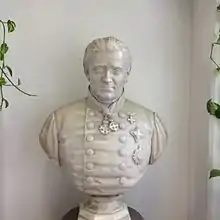Alessandro Riberi
Alessandro Riberi (Stroppo, 24 April 1794 – Cuneo, 18 November 1861) was a surgeon, physician, academic and Italian politician.
Alessandro Riberi | |
|---|---|
 Alessandro Riberi's bust in Turin | |
| Born | 24 April 1794 Stroppo, Italy |
| Died | 18 November 1861 (aged 67) Cuneo, Italy |
| Nationality | Italian |
| Scientific career | |
| Fields | Medicine, politics |
Biography
Alessandro Riberi was born on 24 April 1794 in Stroppo. He graduated at the University of Turin in Surgery in 1815 and then in Medicine at the University of Genova in 1817. In 1820 he became assistant in the clinic of San Giovanni Hospital. In 1822 he was appointed assistant surgeon and anatomic engraver in the same hospital. In the same year he was named major surgeon by King Charles Felix. In 1826 he became operative surgery and obstetrics professor and then he founded the Laboratory of Anatomy and Surgery. When Charles Albert became the King of Sardinia in 1831, Riberi was appointed surgeon of the Royal House. In 1843 he was named president of the Major Military Council of Health and he founded the Military Medicine Journal. He pushed through a law which stated that each military doctor must be a surgeon too.[1] He introduced the use of anesthesia and acupuncture in hospitals.[2] In 1848 he was appointed member of the Council of Dronero and the next year he got into the Italian Senate. Since 1848 he was counselor of the king and then member of the Superior Council of Education. In 1849 he went to Oporto to cure his dying friend Charles Albert.[3] He was an extraordinary member of the Superior Council of Health, board of directors of the clinic of San Giovanni Hospital, of the Work of Motherhood Administration and of Charity General Hospice in Turin. He was also a member of France Medicine Academy, of San Pietroburgo medical-surgeon Royal Academy, of Milan physical-medical-statistics Academy, of Marsiglia Academic Society of Medicine, of Barcellona and Lisbon Medical Societies, and he was president of the faculty of Medicine and Surgery of the University of Turin. He was a skillful surgeon. Riberi's students could admire his safety, his calm, his foresight and his orderliness during surgical operations.[4] In 1861 he tried to treat in vain Camillo Benso, Count of Cavour. He never got married and he was always kind with everyone. In the last years of his life he opened a pathological museum in San Giovanni Hospital in which he had been surgeon for thirty-five years. He renounced to salary to improve the hospital. He died in 1861 because of entero rheumatic peritonitis. He is buried in the Monumental Cemetery of Turin.
References
- Mario Umberto Dianzani, Excursus sulla storia della Facoltà di Medicina, Biblioteca Centralizzata di Medicina e Chirurgia – Polo biologico (Sito Università Degli studi di Torino Archived 25 July 2014 at the Wayback Machine)
- Bruno P. Pieroni, Sanita: nuovo potere , Fatti e personaggi degli ultimi 30 anni raccontati da un inviato nel mondo della salute, Springer-Verlag, Milano 2004, p.77 (on line).
- Atti della reale accademia di Medicina di Torino, Vol. V, Tipografia C. Favale e Compagnia, Torino 1869, pp.218–220 (on line).
- Gazzetta medica italiana. Province Sarde, Anno XII, Serie II, Vol. XI, Tipografia di Gaetano Biancardi, Torino 1861, p.380 (on line).